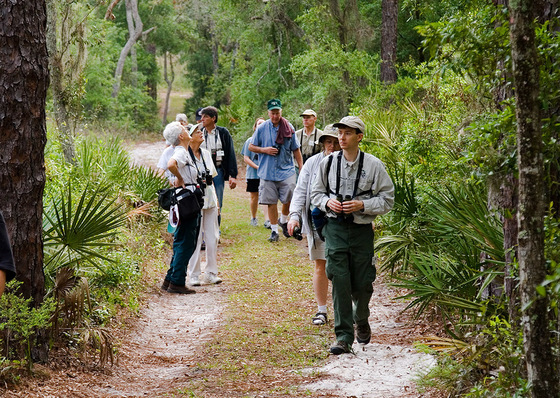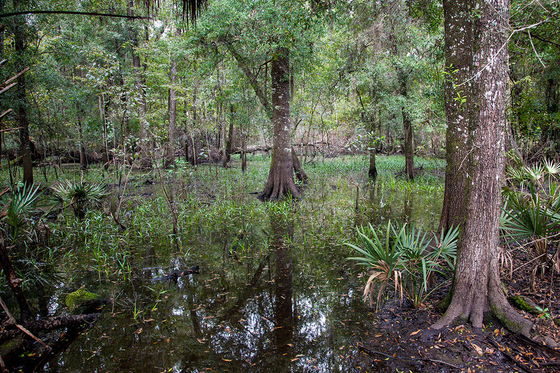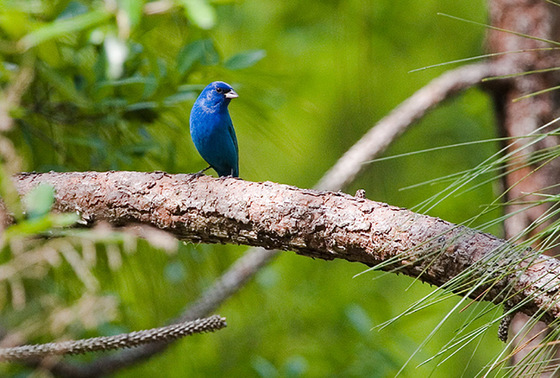|
By Peter Kleinhenz
Goodbye, 2017. The year and the
holiday season signaling its termination are over. The trajectory of how my
past year has gone resembles a silhouette of the Himalayas. Bringing a new kitten home and seeing my first tiger in the wild were highs while a blown head gasket
and total-body chigger infestations were not. These moments probably seem as
related as a Deadhead and a fan of Justin Bieber, but a consistent theme
exists: all of these intense memories involve me and someone else.
Why am
I mentioning this? You see, the time of resolutions is upon us and if yours
involve family, friends, exercise or the outdoors (and they better) then I’ve
got a place to introduce you to. It’s a locale especially conducive to making
memories with others and it’s called Chinsegut Wildlife and Environmental Area
(WEA).
 Open stands of longleaf pine define the fire-maintained ecosystem at Chinsegut WEA, photo by Matt Koenig
At 853 acres, Chinsegut WEA takes up less space than
almost any other property that the Florida Fish and Wildlife Conservation
Commission (FWC) solely manages. What this Hernando County property lacks in
size, however, it more than makes up for with habitats and the species that
inhabit them. Male gopher frogs call to their mates in wet prairies, the
unusual short-tailed snake pursues crowned snakes in the sandhills, and bobcats
stalk through old-growth longleaf pines.
I love Chinsegut. I’ve visited twice, and both
times I was struck by how genuinely wild the place feels even though it’s
neither large nor far from heavily developed areas. After all, 6.7 miles of
hiking trails somehow wind through the property and, walking beneath the
200-year-old pines, this feels like a place that squeezed through the
bottleneck so many other natural areas in the region succumbed to.
 Birders explore Chinsegut WEA, a site on the Great Florida Birding and Wildlife Trail, FWC photo
Nobody knows Chinsegut better
than its education director, Gina Long. She described why Chinsegut WEA feels
this way.
“Since the early 1900s, it’s been a conserved
property,” she stated. “So there haven’t been a lot of changes to the property
since the first family settled this site, following Native American occupation. There was really only one family that
ever lived here, and then after that the land was conserved. So, going back all
the way to the early 1900s, there was just this incredible diversity of
wildlife and this whole area had essentially been protected from outside
contact.”
 Visitors experience a variety of habitats at Chinsegut, photo by David Moynahan
In the late 1970s, FWC staff
took notice of the property. A biologist conducting a spotlight survey for deer
visited the area and was so swayed by the potential opportunities there that he
proposed that an educational center be built on site. By 1986, it was. What
started as a few education programs targeted at children has blossomed into
much more. These days, Gina and her staff teach outdoor skills, photography
workshops and animal identification classes to members of the community, old
and young alike.
“We offer opportunities for people,
and that’s all ages, to visit May’s Prairie, which is an isolated wetland, to
help us collect samples of water quality and also monitor wildlife diversity,”
Gina elaborated. “We’re catching macroinvertebrates from the water itself and
kind of monitoring the changes over the years in the things we’re able to
collect there. We also offer opportunities to use some of our specialized
wildlife viewing equipment to take a live look underground in gopher tortoise
burrows. And also, in collaboration with the southwest region volunteer
coordinator, we offer the opportunity for folks to take a live look into
uninhabited bird nest boxes just to get an idea and a feel for some of the
programs we work on with red-cockaded woodpeckers and American kestrels in the
area.” |
|
 |
Observing wildlife together, FWC photo
Gina
has a tough job. Her mission is to provide meaningful and memorable experiences
for visitors while also instilling a deeper conservation ethic within them. In
today’s world, where technology can both tear people away from nature and tear
nature apart, it can be a juggling act to channel behaviors in ways that help
the environment long-term.
 Chinsegut is a choice location for seeing many birds such as this male indigo bunting, photo by David Moynahan
“We’re
sort of fortunate in that, in our area, there are a lot of families that enjoy
the outdoors,” Gina told me. “Over the last few decades, our appreciation of
the outdoors has changed as a culture and it is nice to be in a position where
I get to foster a connection between people and nature, and charge their
enthusiasm for wildlife and conservation. We also try to help direct people to
find the right location for activities they enjoy in the outdoors, where the
land use designation matches their intended activities so that they can enjoy
them safely. Our ideal outcome is that, through visiting Chinsegut,
individuals will be better informed how and why wildlife and natural areas are
protected and managed. We also hope that visitors will be motivated to learn
more or take an active role in conservation.”
Chinsegut WEA has continued to evolve after the
educational center was first built in 1986. Today, increased classroom space
both indoors and outdoors allows for more people to participate in programming.
The Florida National Scenic Trail, as of this year, officially passes through
the property. Habitat restoration and active management has the property looking
better than ever. Furthermore, as time passes, we as a society have a
progressively better idea of how beneficial time spent in a place like
Chinsegut WEA can be.
 The Chinsegut Conservation Center hosts many education programs and hikes throughout the year, photo by Gina Long
“[Time in nature] helps with a variety of challenges,” Gina
noted. “People with a variety of older age issues, Alzheimer’s, memory
loss…when they’re exposed to nature and exposed to sensory experiences, it
improves their quality of life. Children that suffer from attention deficit
disorder benefit greatly from getting outdoors. There’s a whole host of medical
studies that could be cited on the benefits that nature has. And it’s also good
for families, for bonding."
Whether you’re into the outdoors or not, I can
almost guarantee that your best moments of 2018 will involve somebody else. In
addition to its memory-making potential in terms of habitats, wildlife and
available activities, Chinsegut WEA serves as a perfect setting for you to
simply spend time with loved ones outside. I don’t know about you, but doing
just that sounds like a perfect New Year’s resolution to me.
 At Chinsegut, people of all ages learn outdoor skills, animal identification, nature photography (shown above) and much more, photo by Gina Long
The
start of 2018 has brought cooler temperatures, making this the perfect time to
visit Chinsegut
WEA. Check the event
calendar to find programs that might interest you. Maybe 2018 will be the
year you explore a
wildlife management area you’ve never been to before or try a new outdoor
activity. The 75th anniversary of Florida’s wildlife management
area system wraps up on January
27 at Tosohatchee WMA, so come help celebrate! You will have the chance to
learn more about volunteer opportunities, wildlife that FWC manages and the Florida
Nature Trackers program. Hope to see you there!
|